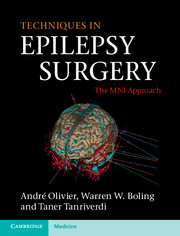Book contents
- Frontmatter
- Contents
- Acknowledgment
- Preface
- 1 History of epilepsy surgery
- 2 The search for the epileptic focus: investigation of the surgical candidate
- 3 Surgical anatomy
- 4 Neuronavigation and preoperative brain mapping
- 5 Stereoelectroencephalography (stereotactic intracranial recording)
- 6 Anesthesia and awake procedure
- 7 Peroperative brain mapping
- 8 Endopial resection (intervascular endopial gyral emptying)
- 9 Surgery of temporal lobe epilepsy: cortico-amygdalohippocampectomy
- 10 Surgery of temporal lobe epilepsy: transcortical selective amygdalohippocampectomy
- 11 Surgery of central area epilepsy
- 12 Surgery of frontal lobe epilepsy
- 13 Surgery of parietal lobe epilepsy
- 14 Surgery of insular lobe epilepsy
- 15 Surgery of occipital lobe epilepsy
- 16 Hemispherectomy
- 17 Callosotomy
- 18 Epilepsy and brain tumors
- 19 Surgical treatment of cortical dysplasias
- 20 Reoperations in failed epilepsy surgery
- 21 Alternative procedures in surgery for epilepsy
- 22 Complications of epilepsy surgery
- 23 Quality of life after epilepsy surgery
- Index
- References
8 - Endopial resection (intervascular endopial gyral emptying)
Published online by Cambridge University Press: 05 October 2012
- Frontmatter
- Contents
- Acknowledgment
- Preface
- 1 History of epilepsy surgery
- 2 The search for the epileptic focus: investigation of the surgical candidate
- 3 Surgical anatomy
- 4 Neuronavigation and preoperative brain mapping
- 5 Stereoelectroencephalography (stereotactic intracranial recording)
- 6 Anesthesia and awake procedure
- 7 Peroperative brain mapping
- 8 Endopial resection (intervascular endopial gyral emptying)
- 9 Surgery of temporal lobe epilepsy: cortico-amygdalohippocampectomy
- 10 Surgery of temporal lobe epilepsy: transcortical selective amygdalohippocampectomy
- 11 Surgery of central area epilepsy
- 12 Surgery of frontal lobe epilepsy
- 13 Surgery of parietal lobe epilepsy
- 14 Surgery of insular lobe epilepsy
- 15 Surgery of occipital lobe epilepsy
- 16 Hemispherectomy
- 17 Callosotomy
- 18 Epilepsy and brain tumors
- 19 Surgical treatment of cortical dysplasias
- 20 Reoperations in failed epilepsy surgery
- 21 Alternative procedures in surgery for epilepsy
- 22 Complications of epilepsy surgery
- 23 Quality of life after epilepsy surgery
- Index
- References
Summary
Introduction
This chapter is of crucial importance, because it deals with the fundamental approach to the surgery of epilepsy which is the actual selective removal of the epileptogenic brain tissue while leaving in situ the sulci with their content formed by a supportive pia-arachnoid envelope containing the vascular elements. These supportive and vascular elements of the brain do not participate directly in the seizure process, and their resection will result in interference with bypassing blood vessels that is in large part related to postoperative deficits. Indeed, when considering neurological complications in epilepsy surgery, deficits are either due to the actual resection of functional tissue or to the secondary damage to functional areas resulting from the occlusion or damage to blood vessels.
Traditionally, epileptic foci were treated by “en bloc” resections where a lobe or a region of the brain is removed leaving behind a large cavity. During these procedures, the surgeon coagulates and divides numerous blood vessels that terminate within or traverse the resected area. Side effects and complications with this procedure are in large part related to the occlusion and resection of arteries and veins, which in turn may cause edema and operative bleeding. The classical examples are the so-called “temporal lobectomy” and the anterior temporal resection where the actual removal entails the division of several opercular arteries and, at times,of veins running over the cortex. There are usually no side effects or complications if the resection is restricted to a rather “silent area” or because the potential post-occlusion swelling is compensated by a relatively large removal cavity. There are many instances where an “en bloc” resection cannot be carried out for fear of causing infarction in a more distal territory. Typically these are resections in the opercular, central, frontal, and parietal areas, that is to say, where a neocortical removal is often contemplated.
- Type
- Chapter
- Information
- Techniques in Epilepsy SurgeryThe MNI Approach, pp. 92 - 96Publisher: Cambridge University PressPrint publication year: 2012



